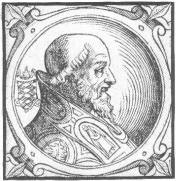 When St. Leo IX died, ex-pope Benedict IX made a final attempt to get back in
the papal throne. The Romans beat him off and then waited for the return of
Hildebrand before taking steps to elect a new pope. Hildebrand had been in
France working for reform and in Leo's name investigating a heretic named
Berengarius. He hurried back to Rome to find that the clergy were anxious to
have an independent election and that he was a favored candidate. Though few
more clearly realized the need for papal independence than Hildebrand, this monk
was no fanatic. He knew that Emperor Henry III would take it very ill if the
Romans elected a pope without consulting him; and he realized that Henry, a
conscientious man, would pick a good candidate. Therefore, Hildebrand persuaded
the Romans to hold up the election and send him to ask Emperor Henry to give the
Romans a pope of their choice.
When St. Leo IX died, ex-pope Benedict IX made a final attempt to get back in
the papal throne. The Romans beat him off and then waited for the return of
Hildebrand before taking steps to elect a new pope. Hildebrand had been in
France working for reform and in Leo's name investigating a heretic named
Berengarius. He hurried back to Rome to find that the clergy were anxious to
have an independent election and that he was a favored candidate. Though few
more clearly realized the need for papal independence than Hildebrand, this monk
was no fanatic. He knew that Emperor Henry III would take it very ill if the
Romans elected a pope without consulting him; and he realized that Henry, a
conscientious man, would pick a good candidate. Therefore, Hildebrand persuaded
the Romans to hold up the election and send him to ask Emperor Henry to give the
Romans a pope of their choice.
Under Hildebrand's guidance they chose Gebhardt, Bishop of Eichstatt, a powerful
minister of the Emperor. Henry, though reluctant to lose his trusty councilor,
consented. Gebhardt himself was also reluctant, but finally he too consented and
went down to Rome, where he was joyously elected and enthroned as Victor II on
April 13, 1055. Gebhardt, count of Calvi, Tollenstein, and Hirschberg, was born
in Suabia sometime around 1018. Through the influence of his uncle Gebhardt,
bishop of Ratisbon, young Gebhardt, though only twenty-four years old, received
the bishopric of Eichstatt. Young though he was, Gebhardt proved to be an
excellent bishop and a top-flight administrator.
Henry soon drew him into the imperial service and made him one of his most
important ministers. Victor II continued the strong reform policy of St. Leo.
And while he was not the man to truckle to the Emperor, he got along very well
with him. This close cooperation of Pope and Emperor enabled the work of reform
to go forward with dispatch. Victor also secured restitution to papal control of
some territory and indeed also the addition of the Duchy of Spoleto to the Papal
States. He relied on Hildebrand to keep the papal finances in some kind of
order. In 1056 Victor visited Henry III at Goslar. A clever diplomat, he
succeeded in appeasing the Emperor's wrath against the house of Tuscany.
Countess Beatrice and her daughter Matilda, who had been state prisoners, were
allowed to return to Italy. Matilda would later repay the papacy for Victor's
kindness. The Pope helped Henry on his death bed, and after this untimely death
Victor did much for the Empress Agnes and her boy Emperor Henry IV, who was only
six years old. By the Lent of 1057 Victor was back in Rome. He used diplomacy to
quiet the restless Normans of South Italy. He made Frederick, abbot of Monte
Cassino and brother of Godfrey, duke of Lorraine, a cardinal.
While he was in Tuscany settling a jurisdictional dispute between the bishops of
Arezzo and Siena, he fell sick and on July 28, this fine reform pope died.
Excerpted from "Popes
Through the Ages" by Joseph Brusher, S.J.

